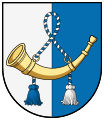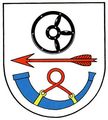Hip horn
The hip horn is a small signal horn that has been known since the Middle Ages . The name is derived from ahd . hiofan , " lament " from.
It was originally made from cow horn . In the further development it got a mouthpiece made of metal. From the 16th century onwards, hip horns made entirely of metal were in use. The medieval knights also used precious designs made of gold and especially ivory ( Olifant ).
The hip horn, which was carried over the shoulder on a shackle, served various purposes. It was designed by night watchmen , fire guards , colonnes , hunters and shepherds used. Bakers, butchers ( Metzgerpost ) and postillons also blew their signals ( post horn ). At times the designation hip horn was also used, which was derived from the fashion of wearing the horn on a longer cord on the hip.
The hunting horn was developed from the Hifthorn . It is still used today, the most famous being the Fürst-Pless-Horn .
In coats of arms, the depiction of the horn , post horn and hunting horn wind instruments is popular as a common figure . A hunting horn can be found, for example, in the coats of arms of Gönningen , Hövelhof , Rieden or Rösrath . Two horns are shown very small in the coats of arms of Kamenz and Königsberg (Prussia) ; the coat of arms of Horn (Lower Austria) is even eloquent .
Old coat of arms of the municipality of Beilstein on the Moselle

















